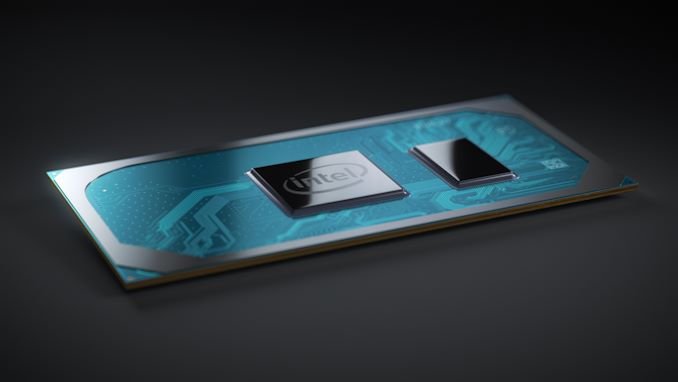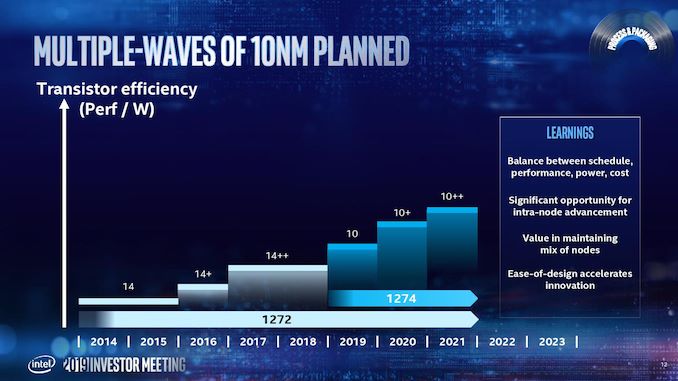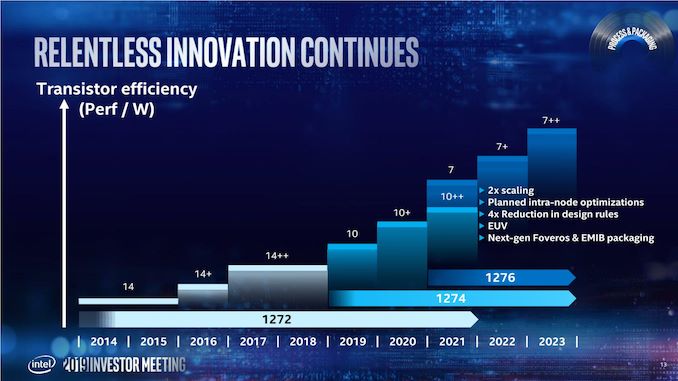Intel Q3 2019 Fab Update: 10nm Product Era Has Begun, 7nm On Track
by Anton Shilov on October 28, 2019 9:30 AM EST
After years of delays, Intel is finally shipping its 10 nm processors in high volume, and the company is preparing to fire up another fab to produce an even larger volume of 10nm products. Along with producing more of the company's existing Ice Lake-U/Y products, Intel is also planning for server CPUs and GPUs as well, with Ice Lake-SP CPU as well as the DG1 GPU already up and running in Intel’s labs. Meanwhile, even farther out, Intel is eyeing 2021 for the rollout of its EUV-based 7nm process.
During its earnings call on Thursday, Intel said that so far 18 premium systems based on its 10th Generation Core (Ice Lake) processors have been formally introduced and 12 more are expected in 2019. Right now, the company produces all of its 10 nm CPUs in Hillsboro, Oregon and Kiryat Gat, Israel. Starting next quarter, the company expects 10 nm chips to also ship from its Chandler, Arizona, fab, which will increase supply of Ice Lake processors and will get Intel prepared for a broader use of the manufacturing process that had caused company a lot of troubles.
In addition to client Ice Lake CPUs and Agilex FPGAs that are currently shipping, Intel’s 10 nm portfolio includes datacenter-grade Xeon (Ice Lake-SP) processors due in the second half of 2020, discrete DG1 GPU(s), an AI inference accelerator, and a 5G base station SoC. One thing to keep in mind here is that Intel will use different iterations of its 10 nm technology to make different chips.
Here is what Bob Swan, CEO of Intel, said:
“The Intel 10 nm product era has begun and our new 10th Gen Core Ice Lake processors are leading the way. In Q3, we also shipped our first 10 nm Agilex FPGAs. In 2020, we will continue to expand our 10 nm portfolio with exciting new products including an AI inference accelerator, 5G base station SoC, Xeon CPUs for server storage and network, and a discrete GPU. This quarter we have achieved power on exit for our first discrete GPU DG1, an important milestone.”
The big news here is that Intel produced the first samples of its DG1 GPU back in Q3, which means that the company now has actual silicon to work with. The chip will undergo at least one more iteration before it will be ready to ship commercially, but it is a good sign that Intel’s A0 DG1 GPU could be turned on. If Intel wants to launch these GPUs in mid-2020, then this is the right window to begin working on actual silicon.
One of the key operational challenges that Intel faces today in regards of its 10 nm fabrication process are yields, as they thwarted the technology from going HVM (high volume manufacturing) for years. According to Intel, yields are improving ahead of expectations for both for client and datacenter CPUs, though the company did not disclose any numbers.
7nm Technology on Track, 5nm in Development
Meanwhile, with their 10 nm evolution roadmap set till 2021, Intel’s manufacturing technology teams are now focused on 7 nm and 5 nm processes. Along with their 10nm status update, in their earnings call Intel has re-iterated that its EUV-based 7 nm technology was on-track for HVM in 2021, and that development of its 5 nm node was proceeding as planned.
According to Intel, having learnt from its 10 nm fabrication process and how its problems harmed its roadmap, the company has radically changed its approach to development of manufacturing technologies and actual products. The company no longer sets ultra-ambitious goals for scaling each node, but attempts to find a right balance between performance, power, cost, and timing. Furthermore, the manufacturer no longer designs products for a particular process, but intends to use the most optimal one it has at the moment. Overall, Intel says that it intends to get back to its usual process technology cadence and introduce brand-new technologies every 2 to 2.5 years, and recapture its process leadership in the future.
Intel’s first product to be made using its 7 nm manufacturing technology is its ‘big’ GPU for high performance computing that is due in Q4 2021, two years after the launch of the 10 nm Ice Lake CPU. Intel says that its 7 nm process is well on-track and the product will be released as planned. While Intel also plans to use 7+ and 7++ technologies in 2022 and 2023, the company is already working on its 5 nm process and is currently ‘engineering’ it, which means that the path-finding stage has been passed and fundamental things like materials and transistor structures were set.
Here is what Bob Swan, CEO of Intel, told analysts and investors on Thursday:
“We are on track to launch our first 7 nm based product, a datacenter-focused discrete GPU, in 2021, two years after the launch of 10 nm [products]. We are also well down the engineering path on 5 nm.”
Related Reading:
- Intel Begins Commercial Shipments of 10nm Ice Lake CPUs to OEMs
- The Ice Lake Benchmark Preview: Inside Intel's 10nm
- Examining Intel's Ice Lake Processors: Taking a Bite of the Sunny Cove Microarchitecture
- Intel Details Manufacturing through 2023: 7nm, 7+, 7++, with Next Gen Packaging
- Intel Process Technology Update: 10nm Server Products in 1H 2020, Accelerated 7nm in 2021
Source: Intel












59 Comments
View All Comments
name99 - Monday, October 28, 2019 - link
And what have they said about tihe ACTUAL 3nm process?https://www.tsmc.com/english/dedicatedFoundry/tech...
THAT is how it’s done.
TEAMSWITCHER - Monday, October 28, 2019 - link
One this is for certain ... there is never going to be a 0 nm process. What we are witnessing, is nothing short of the end ... of the Golden Age of Semi-Conductors.TheJian - Monday, October 28, 2019 - link
"yields are improving ahead of expectations for both for client and datacenter CPUs"So you've produced 16-32 core cpus on 10nm in HV? I only see quads and small chips.
Until you are selling at least a 16 core 100w 10nm you haven't started. 7nm after only 2yrs? LOL Only because 10nm was 4yrs late (still not out IMHO).
Not sure how BIG this 7nm gpu is either, as Intel said the first discrete card is SMALL CU count and LOW END. I'm confused by their statements here, as I though wimp desktop gpu was coming first (what a waste, like AMD 7nm NON king first...ROFL), and hope reality is BIG first as it should ALWAYS be if you want to win. Kings first, crap second.
Rudde - Tuesday, October 29, 2019 - link
Intel will release a small gpu on 10nm and later a bigger one on 7nm. I believe both are aimed at datacenter.Dizoja86 - Tuesday, October 29, 2019 - link
I'm pretty intrigued to see how 10nm impacts Intel's CPU lineup. Even at 14nm, their mobile chips have been untouchable from a power consumption perspective compared to AMD's offerings, so I'm wondering just how this shift will impact core counts and boost rates in that 15W (or lower) envelope.On the desktop side, here's hoping they can drop their total power draw down a bit while increasing clock speeds, although their current power draw isn't something that I'm particularly impacted by.
Regardless, as others have said, I'll believe it when I see it at this point. Current 7nm processes aren't particularly impressive, so I'm holding my breath that Intel's 10nm can match or beat what's currently on the market.
Rudde - Tuesday, October 29, 2019 - link
Everyone keeps talking about clock speeds, and that is exactly the reason why we'll continue to see 14nm cpus. 10nm has lower clock speeds and I don't believe Intel will ever reach 14nm clock speeds ever again. EUV (7nm) might be able to reach higher clock speeds than 10nm, but I doubt they will reach 5GHz beyond short bursts.5080 - Tuesday, October 29, 2019 - link
That's not true. Lower nano meter number = higher efficiency + higher performance + power efficiency.Less power also results in the generation of less heat and thus allowing us to increase the clock speeds further.
TheLightbringer - Tuesday, October 29, 2019 - link
I'll believe it when I see it.But Intel have been toying with the 10nm and not delivering for a long time. And sadly press and investors keep believing in them.
evilpaul666 - Wednesday, November 27, 2019 - link
Is there a reason nobody is making Pentium M Banias-style desktop setups with whatever the "shipping" 10nm chips are? Or no manufacturer is ignoring Intel spec with a higher TDP configuration laptop with the 10nm chips?